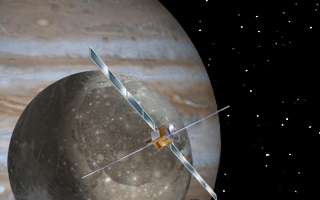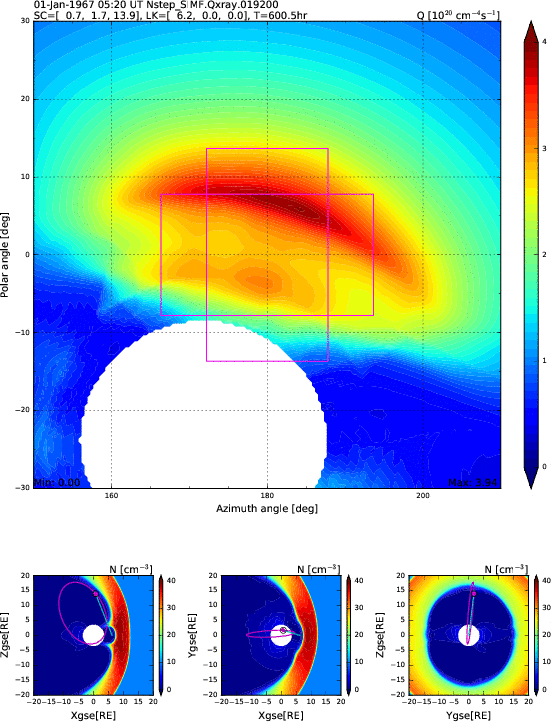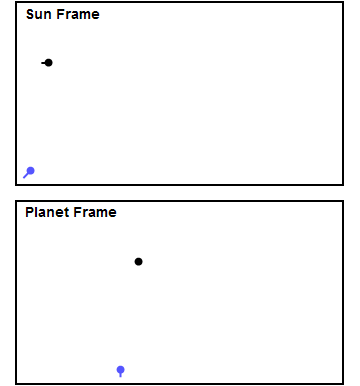|
Jupiter Icy Moons Explorer
The Jupiter Icy Moons Explorer (JUICE) is an interplanetary spacecraft in development by the European Space Agency (ESA) with Airbus Defence and Space as the main contractor. The mission will study three of Jupiter's Galilean moons: Ganymede, Callisto, and Europa (excluding the volcanically active Io; Io is not an icy moon) all of which are thought to have significant bodies of liquid water beneath their surfaces, making them potentially habitable environments. The spacecraft is scheduled to launch in April 2023 and will reach Jupiter in July 2031 after four gravity assists and eight years of travel. In December 2034, the spacecraft will enter orbit around Ganymede for its close up science mission, becoming the first spacecraft to orbit a moon other than the moon of Earth. The selection of this mission for the L1 launch slot of ESA's Cosmic Vision science programme was announced on 2 May 2012. Its period of operations will overlap with NASA's ''Europa Clipper'' mission, lau ... [...More Info...] [...Related Items...] OR: [Wikipedia] [Google] [Baidu] |
Planetary Science
Planetary science (or more rarely, planetology) is the scientific study of planets (including Earth), celestial bodies (such as moons, asteroids, comets) and planetary systems (in particular those of the Solar System) and the processes of their formation. It studies objects ranging in size from micrometeoroids to gas giants, aiming to determine their composition, dynamics, formation, interrelations and history. It is a strongly interdisciplinary field, which originally grew from astronomy and Earth science, and now incorporates many disciplines, including planetary geology, cosmochemistry, atmospheric science, physics, oceanography, hydrology, theoretical planetary science, glaciology, and exoplanetology. Allied disciplines include space physics, when concerned with the effects of the Sun on the bodies of the Solar System, and astrobiology. There are interrelated observational and theoretical branches of planetary science. Observational research can involve combinations of spac ... [...More Info...] [...Related Items...] OR: [Wikipedia] [Google] [Baidu] |
SMILE (satellite)
Solar wind Magnetosphere Ionosphere Link Explorer (SMILE) is a planned joint venture mission between the European Space Agency and the Chinese Academy of Sciences. SMILE will image for the first time the magnetosphere of the Sun in soft X-rays and UV during up to 40 hours per orbit, improving our understanding of the dynamic interaction between the solar wind and Earth's magnetosphere. The prime science questions of the SMILE mission are * What are the fundamental modes of the dayside solar wind/magnetosphere interaction? * What defines the substorm cycle? * How do coronal mass ejection-driven storms arise and what is their relationship to substorms? As of April 2021, SMILE is expected to launch in November 2024. Overview The mission will observe the solar wind interaction with the magnetosphere with its X-ray and ultraviolet cameras (SXI and UVI), gathering simultaneous images and videos of the dayside magnetopause (where Earth's magnetosphere meets the solar wind), the pola ... [...More Info...] [...Related Items...] OR: [Wikipedia] [Google] [Baidu] |
Advanced Telescope For High Energy Astrophysics
Advanced Telescope for High-ENergy Astrophysics (''Athena'') is an X-ray observatory mission selected by European Space Agency (ESA) within its Cosmic Vision program to address the Hot and Energetic Universe scientific theme. ''Athena'' will operate in the energy range of 0.2–12 keV and will offer spectroscopic and imaging capabilities exceeding those of currently operating X-ray astronomy satellites – e.g. the Chandra X-ray Observatory and XMM-Newton – by at least one order of magnitude on several parameter spaces simultaneously. Mission The primary goals of the mission are to map hot gas structures, determine their physical properties, and search for supermassive black holes. History and development The mission has its roots in two concepts from the early 2000s, XEUS of ESA and Constellation-X Observatory (Con-X) of NASA. Around 2008, these two proposals were merged into the joint NASA/ESA/JAXA International X-ray Observatory (IXO) proposal. In 2011, IXO was with ... [...More Info...] [...Related Items...] OR: [Wikipedia] [Google] [Baidu] |
Europa Jupiter System Mission – Laplace
The Europa Jupiter System Mission – Laplace (EJSM-Laplace) was a proposed joint NASA/ESA uncrewed space mission slated to launch around 2020 for the in-depth exploration of Jupiter's moons with a focus on Europa, Ganymede and Jupiter's magnetosphere. The mission would have comprised at least two independent elements, NASA's Jupiter Europa Orbiter (JEO) and ESA's Jupiter Ganymede Orbiter (JGO), to perform coordinated studies of the Jovian system. The Japan Aerospace Exploration Agency (JAXA) and the Roscosmos (Russian Space Agency) had expressed their interest in contributing to EJSM-Laplace, although no deals had been finalized. JEO was estimated to cost US$4.7 billion, while ESA would spend US$1.0 billion (€710 million) on JGO. In April 2011, European Space Agency (ESA) stated that it seemed unlikely that a joint US–European mission will happen in the early 2020s given NASA's budget, so ESA continued with its initiative, called the Jupiter Icy Moons Explorer (JUICE) t ... [...More Info...] [...Related Items...] OR: [Wikipedia] [Google] [Baidu] |
Jupiter Ganymede Orbiter
Jupiter Ganymede Orbiter (JGO) was a part of the international Europa Jupiter System Mission (EJSM). It was a proposed orbiter by the ESA slated for lift-off in 2020.Anil K. Maini, Varsha Agrawal - Satellite Technology: Principles and Applications (2010) - Page 584 (Google Books Link) Plans for the mission include detailed studies of Ganymede and as well as the Jovian |
JUICE Spacecraft Concept
Juice is a drink made from the extraction or pressing of the natural liquid contained in fruit and vegetables. It can also refer to liquids that are flavored with concentrate or other biological food sources, such as meat or seafood, such as clam juice. Juice is commonly consumed as a beverage or used as an ingredient or flavoring in foods or other beverages, as for smoothies. Juice emerged as a popular beverage choice after the development of pasteurization methods enabled its preservation without using fermentation (which is used in wine production). The largest fruit juice consumers are New Zealand (nearly a cup, or 8 ounces, each day) and Colombia (more than three quarters of a cup each day). Fruit juice consumption on average increases with a country's income level. Etymology The word "juice" comes from Old French in about 1300; it developed from the Old French words "''jus, juis, jouis''", which mean "liquid obtained by boiling herbs". The "Old French ''jus'' "juice, s ... [...More Info...] [...Related Items...] OR: [Wikipedia] [Google] [Baidu] |
Europa Clipper
Europa Clipper (previously known as Europa Multiple Flyby Mission) is an interplanetary mission in development by NASA comprising an orbiter. Planned for launch in October 2024, the spacecraft is being developed to study the Galilean moon Europa through a series of flybys while in orbit around Jupiter. This mission is a scheduled flight of the Planetary Science Division, designated a Large Strategic Science Mission, and funded under the Planetary Missions Program Office's Solar System Exploration program as its second flight. It is also supported by the new Ocean Worlds Exploration Program. ''Europa Clipper'' will perform follow-up studies to those made by the ''Galileo'' spacecraft during its eight years in Jupiter orbit, which indicated the existence of a subsurface ocean underneath Europa's ice crust. Plans to send a spacecraft to Europa were initially conceived with projects such as ''Europa Orbiter'' and ''Jupiter Icy Moons Orbiter'', in which a spacecraft would be inje ... [...More Info...] [...Related Items...] OR: [Wikipedia] [Google] [Baidu] |
NASA
The National Aeronautics and Space Administration (NASA ) is an independent agency of the US federal government responsible for the civil space program, aeronautics research, and space research. NASA was established in 1958, succeeding the National Advisory Committee for Aeronautics (NACA), to give the U.S. space development effort a distinctly civilian orientation, emphasizing peaceful applications in space science. NASA has since led most American space exploration, including Project Mercury, Project Gemini, the 1968-1972 Apollo Moon landing missions, the Skylab space station, and the Space Shuttle. NASA supports the International Space Station and oversees the development of the Orion spacecraft and the Space Launch System for the crewed lunar Artemis program, Commercial Crew spacecraft, and the planned Lunar Gateway space station. The agency is also responsible for the Launch Services Program, which provides oversight of launch operations and countdown management f ... [...More Info...] [...Related Items...] OR: [Wikipedia] [Google] [Baidu] |
Space
Space is the boundless three-dimensional extent in which objects and events have relative position and direction. In classical physics, physical space is often conceived in three linear dimensions, although modern physicists usually consider it, with time, to be part of a boundless four-dimensional continuum known as spacetime. The concept of space is considered to be of fundamental importance to an understanding of the physical universe. However, disagreement continues between philosophers over whether it is itself an entity, a relationship between entities, or part of a conceptual framework. Debates concerning the nature, essence and the mode of existence of space date back to antiquity; namely, to treatises like the ''Timaeus'' of Plato, or Socrates in his reflections on what the Greeks called ''khôra'' (i.e. "space"), or in the ''Physics'' of Aristotle (Book IV, Delta) in the definition of ''topos'' (i.e. place), or in the later "geometrical conception of place" as "spac ... [...More Info...] [...Related Items...] OR: [Wikipedia] [Google] [Baidu] |
Gravity Assist
In orbital mechanics and aerospace engineering, a gravitational slingshot, gravity assist maneuver, or swing-by is the use of the relative movement (e.g. orbit around the Sun) and gravity of a planet or other astronomical object to alter the path and speed of a spacecraft, typically to save propellant and reduce expense. Gravity assistance can be used to accelerate a spacecraft, that is, to increase or decrease its speed or redirect its path. The "assist" is provided by the motion of the gravitating body as it pulls on the spacecraft. Any gain or loss of kinetic energy and velocity by a passing spacecraft is correspondingly lost or gained by the gravitational body, in accordance with Newton's Third Law. The gravity assist maneuver was first used in 1959 when the Soviet probe Luna 3 photographed the far side of Earth's Moon and it was used by interplanetary probes from Mariner 10 onward, including the two Voyager probes' notable flybys of Jupiter and Saturn. Explanation A ... [...More Info...] [...Related Items...] OR: [Wikipedia] [Google] [Baidu] |
Planetary Habitability
Planetary habitability is the measure of a planet's or a natural satellite's potential to develop and maintain environments hospitable to life. Life may be generated directly on a planet or satellite endogenously or be transferred to it from another body, through a hypothetical process known as panspermia. Environments do not need to contain life to be considered habitable nor are accepted habitable zones (HZ) the only areas in which life might arise. As the existence of life beyond Earth is unknown, planetary habitability is largely an extrapolation of conditions on Earth and the characteristics of the Sun and Solar System which appear favorable to life's flourishing. Of particular interest are those factors that have sustained complex, multicellular organisms on Earth and not just simpler, unicellular creatures. Research and theory in this regard is a component of a number of natural sciences, such as astronomy, planetary science and the emerging discipline of astrobio ... [...More Info...] [...Related Items...] OR: [Wikipedia] [Google] [Baidu] |
Io (moon)
Io (), or Jupiter I, is the innermost and third-largest of the four Galilean moons of the planet Jupiter. Slightly larger than Earth’s moon, Io is the fourth-largest moon in the Solar System, has the highest density of any moon, the strongest surface gravity of any moon, and the lowest amount of water (by atomic ratio) of any known astronomical object in the Solar System. It was discovered in 1610 by Galileo Galilei and was named after the mythological character Io, a priestess of Hera who became one of Zeus's lovers. With over 400 active volcanoes, Io is the most geologically active object in the Solar System. This extreme geologic activity is the result of tidal heating from friction generated within Io's interior as it is pulled between Jupiter and the other Galilean moons—Europa, Ganymede and Callisto. Several volcanoes produce plumes of sulfur and sulfur dioxide that climb as high as above the surface. Io's surface is also dotted with more than 100 mountains that ... [...More Info...] [...Related Items...] OR: [Wikipedia] [Google] [Baidu] |






.jpg)
